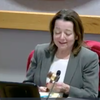Tech Valley HS on the move
The Enterprise — Melissa Hale-Spencer
“The standards are exactly the same,” Dan Liebert, principal of Tech Valley High School, tells the Guilderland School Board Tuesday night. “What is different are the assessment practices of students go beyond content.” Listening to his presentation, at the bottom of the frame, are Superintendent Marie Wiles, left, and board President Barbara Fraterrigo.
The Enterprise — Melissa Hale-Spencer
Happy student: Sara Sisson, of Guilderland, a senior at Tech Valley High School, smiles at her principal, Dan Leibert, at the close of their presentation to the Guilderland School Board. Projected between them is the school’s mission: Collaboration, innovation, success. Sisson told the board that Tech Valley brought her out of her “shell,” preparing her for life’s challenges; she plans to be a physical therapist.
GUILDERLAND — Tech Valley High School — an innovative regional school that draws students from seven counties — is moving to the Nano College campus next year in the district’s catchment area. Guilderland teachers have been visiting the school this year to learn about adapting the project-based, shared-discipline learning into their own classrooms.
Tuesday night, Tech Valley’s principal along with a student at the school, the mother of a graduate, and several teachers spoke to the Guilderland School Board since a few of the board’s members had earlier expressed doubts about continuing to send Guilderland students to the school.
After the meeting, Rose Levy, the board member who first asked why tuition to Tech Valley wasn’t included in proposed cuts for next year as Guilderland tries to close a $1.8 million budget gap, told The Enterprise that the presentation hadn’t changed her mind.
“I have nothing against Tech Valley High School,” she said. “My concern is: How do we justify spending that much for four kids when we are cutting our own programs and teachers.”
Guilderland would spend roughly $5,700 for each Tech Valley student next year, after getting 55.9 percent back in state aid. Next year’s Tech Valley tuition is $12,990 while out-of district students pay $13,575 to attend Guilderland High School.
The school board has been sharply divided on Tech Valley High School since it decided to send its first student five years ago.
“This is an entirely new way of delivering education to a student,” said the late John Dornbush, who was then vice president of the board. “This is the first attempt in New York State to do this…We should support this 100 percent.”
The late Hy Dubowski then countered he was more concerned about meeting the needs of children in the district who were struggling. Colleen O’Connell, who is still on the board, said then that a lot of special-education placements cost $18,000.
During this Tuesday’s presentation, Dan Liebert, the principal of Tech Valley High, said the school is teaching the skills that higher education and businesses are demanding. Currently, he said, the school has approximately 30 students in each grade, although 40 would be optimum.
Forty-six school districts are eligible to send students who are not selected by ability level or testing, he said, but they must be “willing to be ready, open, and curious.” A blind lottery is used if more students apply from a school district than the district wants to send.
Tech Valley High is part of a national system of New Tech schools and will serve as a model for some about to open elsewhere in New York State.
Liebert stressed that his school is “not just handing computers to students” but, rather, engages them in learning enabled by technology, and empowers them with a “professional collaborative culture.” The school’s lockers have no locks, he said as trust, respect, and responsibility are stressed.
Each student makes 150 to 160 presentations a year and students are responsible to “give feedback to each other,” said Liebert.
The students must take the same statewide Regents exams as other public-school students in New York and are following the same Common Core standards, but the learning is often project-based and crosses disciplines. Students, as well as being graded on content, are also graded on self-direction, critical thinking, and collaboration.
In addition to meeting state graduation requirements, Tech Valley grads must also complete a senior project, working in a real-world setting; produce a digital portfolio of their work; and be involved in community service. Students from the school’s three graduating classes have gone “from Ivy League to community colleges and everything in between,” said Liebert.
All of the students have graduated, he said, 93 percent are enrolled in college, and about half are pursuing science, technology, engineering, or math.
Sara Sisson, a senior from Guilderland, is completing her fourth year at the school. Speaking extemporaneously, she told the board that Tech Valley High “helped me come out of my shell,” adding, “I was really, really shy.”
Sisson was passionate about her senior project and her advisor complimented her on her presentation: “I blew it out of the park,” Sisson reported with a broad smile.
In a big school, Sisson said, students have “to go searching for support,” but, at Tech Valley, she learned, “If you ask for help, you will get it.”
Sisson said, “I’m going into physical therapy.” That is a career she said she wouldn’t have had the courage to pursue without Tech Valley training because it involved regularly working with strangers.
“You have to be open to new things, to a challenge,” she said she had learned.
Sisson concluded by telling the board, “Thank you for letting me go.”
Millicent Eidson then spoke about her daughter who graduated from Tech Valley High last June and is now happily studying game art and animation in college.
Referring to a recent Enterprise editorial featuring a Tech Valley valedictorian, Eidson stressed, “It’s not a school just for really outstanding students.”
Her daughter had been identified as a special-needs student and had an individualized education program “all the way through,” said Eidson.
O’Connell, long a backer of Tech Valley High School, asked if it hadn’t gotten off to a “slow start” in helping other schools learn about its project-based teaching model. Liebert and others conceded it took time and energy to set up the new school but it is now putting efforts into outreach.
Since the new Common Core standards are student-based, a staffer pointed out it was a “perfect time” to collaborate.
“The standards are exactly the same,” said Liebert. “What is different are the assessment practices of students go beyond content.”
He also said the school hosts 500 to 600 visitors a year.


